Serviços Personalizados
Journal
Artigo
Indicadores
-
 Citado por SciELO
Citado por SciELO -
 Acessos
Acessos
Links relacionados
-
 Similares em
SciELO
Similares em
SciELO
Compartilhar
Finisterra - Revista Portuguesa de Geografia
versão impressa ISSN 0430-5027
Finisterra no.98 Lisboa dez. 2014
ARTIGO ORIGINAL
Outdoor thermal perception in different climatic regions. Initial results from Taichung (Taiwan) and Lisbon (Portugal)
Percepção térmica no exterior em diferentes regiões climáticas. Resultados iniciais para Taichung (Taiwan) e Lisboa (Portugal).
Tzu-Ping Lin1 Henrique Andrade2 Sandra Oliveira3 Ruey-Lung Hwang4 Andreas Matzarakis5
1 Department of architecture, national Cheng Kung University, 1 University road, Tainan 701, Taiwan. e-mail: lin678@gmail.com
2 CEG/IGOT/ULisboa, institute of Geography and spatial Planning, Universidade de Lisboa. Portugal
3 niCif, faculty of Letters, University of Coimbra. Largo da Porta Férrea, 3004-530 Coimbra, Portugal. e-mail: sisoliveira@gmail.com
4 Department of architecture, national United University, 1 Lienda, Miaoli 360, Taiwan. e-mail: rueylung@nuu.edu.tw
5 Albert-Ludwigs-University Freiburg. D-79085 Freiburg. e-mail: matzarak@uni-freiburg.de
ABSTRACT
People living in different climatic regions have adapted to specific weather conditions and their tolerance to high temperatures and wind speeds is diverse. This study analyses the effect of thermal adaptations on the thermal perception of users of outdoor spaces in two different regions: Taichung (Taiwan) and Lisbon (Portugal), by means of field surveys and measurements of weather parameters. The thermal acceptable range, representing the satisfaction of people with thermal conditions, was calculated based on the Physiological equivalent temperature (PET) and the results obtained for each region were compared. People in Lisbon are less satisfied with higher values of PET than in Taiwan, due to the adaptation of local people to higher values of air temperature and relative humidity in Taiwan. On the contrary, people in Lisbon showed a higher tolerance to strong wind, as a result of their exposure to higher average wind speeds than those in Taiwan. The results demonstrated that people’s thermal perceptions vary with different climatic and cultural background. The influence of thermal adaptations in the use of outdoor spaces can contribute to improve the quality of these spaces, adapting them to the preferences of local users.
Keywords: Human biometeorology, thermal perception, Taiwan, Portugal.
RESUMO
As populações de diversas regiões climáticas estão adaptadas a determinados estados do tempo sendo muito diversa a sua toler ância a condições extremas, como altas temperaturas e ventos fortes. analisa-se a importância da tolerância e da adapta ção na percepção térmica dos habitantes de Taichung (Taiwan) e Lisboa (Portugal), baseada na temperatura fisiológica equivalente (PET). Verifica-se que os habitantes de Lisboa ficam mais insatisfeitos com altos valores de PET do que os de Taichung, habituados a temperatura e humidade mais altas. Pelo contrário, os lisboetas têm maior tolerância a ventos fortes, como resultado da sua elevada frequência. O conhecimento da influência da adaptação térmica em espaços exteriores permite aperfeiçoar a qualidade desses espa ços e torná-los mais atractivos.
Palavras-chave: Biometeorologia humana, percepção térmica, Taiwan, Portugal.
RESUME
Perception thermique a l’air libre sous différents climats: une comparaison entre Taiwan et le Portugal. Les gens qui vivent dans des régions climatiquement différentes sont adaptés à certains types de temps et ont un inégal degr é de tolérance aux températures élevées et à la violence des vents. On a comparé l’influence que ces types d’adaptation ont sur les habitants de Taichung (Taiwan) et de Lisbonne (Portugal). La mesure de leur tolérance thermique est basée sur l’indice de températurePhysiologique équivalente (PET). On constate que, pour des valeurs élevées de cet indice, les habitants de Lisbonne sont moins satisfaits que les Taiwanais, mieux habitués à ces valeurs. Par contre les Lisboètes supportent mieux les vents forts, fréquents pour eux. Mieux connaitre les degrés d’adaptation des usagers aux conditions thermiques à l’air libre permettra d’améliorer les caractéristiques des espaces étudiés et de les rendre ainsi plus attractifs.
Mots-clés: Biométéorologie humaine, perception thermique, Taiwan, Portugal.
I. INTRODUCTION
Several studies indicate that the attendance and use of outdoor spaces is significantly correlated with outdoor thermal comfort (Eliasson et al., 2007; Lin, 2009; Nakano and Tanabe, 2004; Nikolopoulou et al., 2001; Thorsson et al., 2007; Thorsson et al., 2004). Some studies demonstrated that these relationships are diverse in different climatic regions (Lin, 2009; Lin et al., 2013a, 2013b). Therefore, it is important to detect and quantify the characteristics of people’s thermal comfort in regions with different climatic conditions. For example, people living in areas with a hot climate may be better adapted to hot weather and tolerate higher thermal conditions than those who are usually exposed to temperate climates. This study compares the characteristics of thermal comfort by means of field surveys in Taichung (Taiwan) and Lisbon (Portugal), in order to validate the effect of thermal adaptations on people’s thermal perceptions in different climatic regions. The main aim of this study is to verify how the long-term regional climatic conditions influence local people’s thermal perceptions.
II. DATA AND METHODS
1. Background of the two surveyed area
In the present study, two areas in different climatic regions have been chosen for comparison: Portugal for the Mediterranean region and Taiwan for the subtropical region. Taiwan (Taichung), located at 23º latitude n with hot-humid climate and Portugal (Lisbon), located at 38 º latitude n with hot-dry summer and mild winters, are the areas analysed (fig. 1). The survey in Taiwan was conducted in 2004 and 2005 in the framework of the FIOT project (Hwang and Lin, 2007; Lin et al., 2011; Lin and Matzarakis, 2008), whereas the thermal comfort data in Portugal was collected in 2006 and 2007, during the four seasons, in the framework of the UrbKlim project (Oliveira and Andrade, 2007; Andrade et al., 2011).
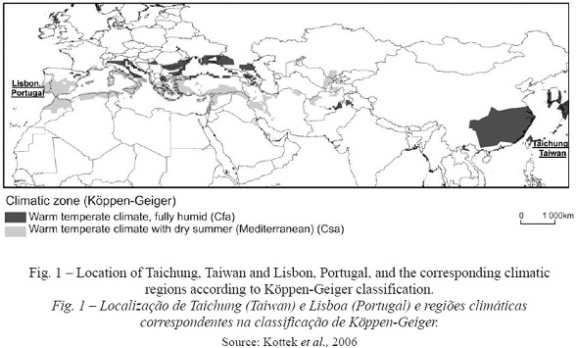
2. Meteorological measurements
In Taiwan, micro-meteorological instruments, positioned on a tripod at a height of 1.1 m above the ground, were used for the measurements and automatic collection of data on thermal comfort parameters, including ambient air temperature, globe temperature, relative humidity, air speed and global radiation. The accuracy of each parameter is ±0.7ºC for air temperature, ±2.5% for relative humidity, ±0.1 m/s for wind speed and ±5 W/m2 for global radiation. In Lisbon, measurements of air temperature, relative humidity, wind speed, short and long wave radiation were made in a similar way to those taken in Taiwan. Mean radiant temperature was calculated from short and long wave radiation; PET was calculated by the rayMan model (Matzarakis et al., 2007, 2010).
3. Questionnaire surveys
People were asked to complete questionnaires about their perception of thermal comfort while meteorological measurements were being taken. The scope of the questionnaires was based on appendix e of the thermal environment survey in Ashrae standard 55 (Ashrae, 2004). in Taiwan, the questionnaire comprised three sections. The first section dealt with demographic information such as age, gender, activity level and the clothing that individuals were wearing. Activity and clothing levels are transferred to the input format through Ashrae standard 55.
In the second section people were asked about their thermal comfort status at the time. The ASHRAE 7-point scales for thermal sensation vote (TSV: -3: cold, -2: cool, -1: slightly cool, 0: neutrality, 1: slightly warm, 2: warm and 3: hot), the 3-point McIntyre preference scales (right now i “want cooler”, “want no change” or “want warmer”), and direct assessments of thermal dissatisfaction (“satisfied” or “dissatisfied”) were used to help respondents to rate their thermal sensation considering their environment. Respondents were also asked to indicate their sensation at the time and general preferences regarding air movement and radiation. A 7point scale from −3 for “very weak wind/sun” to 3 for “very strong wind/sun” with 0 = “neutral” for wind and sun are firstly evaluated. Then a 3-point scale with “i would prefer wind/sunshine weaker”, “i prefer no change in wind/sunshine ” and “i would prefer wind/sunshine to be stronger.” a total of 1,644 data sets of questionnaire surveys were included in this study.
In Lisbon, the questionnaires were designed with equivalent questions and format in relation to Taichung, although the levels of satisfaction were aggregated in a smaller set of classes to be consistent with terminology applied in Portugal. The questionnaires were divided in two main sections: in the first part, the personal characteristics of the interviewees (age, gender, clothing, activity, geographical origin, among others) are described, and in the second part the questions were related to the perception of the atmospheric conditions by the interviewees, with regards to the individual parameters (air temperature, air humidity, wind speed, radiation) and also their overall preferences.
III. RESULTS AND DISCUSSION
A thermal acceptable range is obtained from the estimation of the thermal index (e.g. PET, Physiologically equivalent temperature, Mayer and Höppe, 1987; Höppe, 1999; Matzarakis et al., 1999) and represents the satisfaction of different groups of occupants in relation to thermal conditions. To obtain this range, the dissatisfaction for each temperature bin should be calculated. Based on previous suggestions (de Dear and fountain, 1994), the dissatisfaction can be regarded as a vote by subjects outside the three central categories of the TSV scale: cold (-3), cool (-2), warm (2), and hot (3).
Figure 2 shows the subjects’ dissatisfaction for each temperature bin to which second-degree polynomial curves were fitted. The PET on the lowest point of the curve is the temperature that satisfied the majority of people, i.e. neutral temperature (tn). The same figure indicates that the TN of Taichung (31.3ºC PET) is higher than the one of Lisbon (29.7ºC PET). Furthermore, subjects exposed to certain PET conditions in Lisbon were more dissatisfied with the thermal condition than those in Taichung. For example, when people were exposed to 40ºC PET, around 38% of people in Lisbon expressed dissatisfaction, whereas in Taichung this proportion is around 30%.
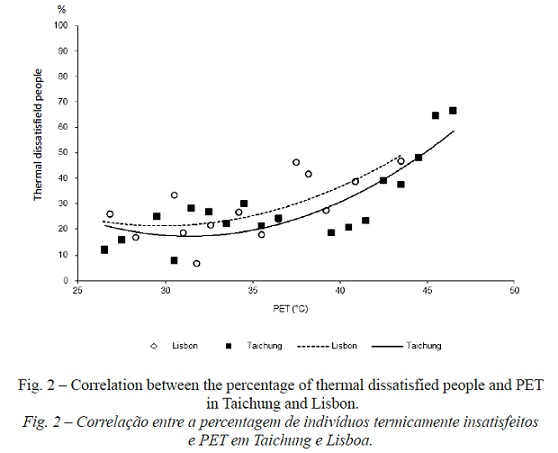
The analytical results can be explained by the following comparisons of longterm climatic conditions in Taichung and Lisbon. Compared to Lisbon, Taichung has higher air temperature (higher than 5ºC) during the hot season (fig. 3). Moreover, relative humidity in summer in Taichung is much higher than in Lisbon. The distribution of these two parameters indicates that Taichung is hotter and more humid than Lisbon.
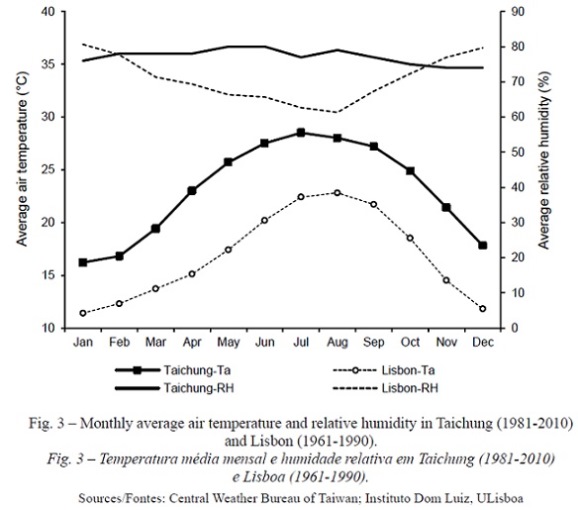
To verify how the long-term solar radiation affects local people’s thermal perception, we calculated the average maximum global radiation of Taichung and Lisbon. This value is, theoretically, the maximum value as modelled by rayMan (Matzarakis et al., 2007, 2010). Figure 4 shows that Taichung has a higher global radiation than Lisbon. This means that people in Taichung are exposed to higher mean radiant temperature (TMRT) values than people in Lisbon. From the comparisons of long-term climate, the higher air temperature, air humidity, and global radiation in Taichung contribute to higher PET values than those in Lisbon. As such, because people in Taichung usually experience higher PET values they have adapted to it, therefore they show higher tolerance to hot conditions than the people in Lisbon. This inference can be verified from the previous thermal comfort classification comparisons between Taiwan and Western/Middle European (Lin and Matzarakis, 2008) and between Taichung and Szeged (Hungary) (Kántor et al., 2012a, 2012b). The adaptation concept, taking into account the variation of individuals’ comfort range with background thermal condition, has been applied in natural ventilated indoor spaces, according to Ashrae 55 (Ashrae, 2010) and en 15251(Cen standard en15251, 2007).
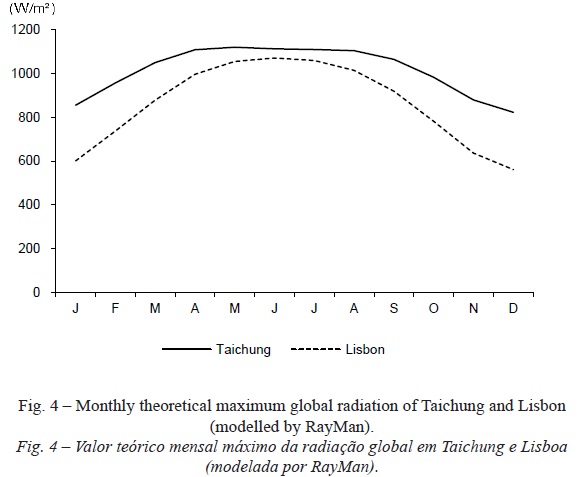
Since wind speed is also an important parameter for outdoor thermal comfort, we further analysed people’s perception to different levels of wind speed, with the same method applied for assessing overall thermal dissatisfaction. Figure 5 shows the wind dissatisfaction for both cities. Unlike what was found for PET, it is obvious that people in Lisbon have much higher tolerance to stronger wind speeds than people in Taichung. The higher average wind speed in Lisbon (around 3.3-4.1m/s), than in Taichung (around 1.6-2.8 m/s), may explain the results, shown in figure 5.
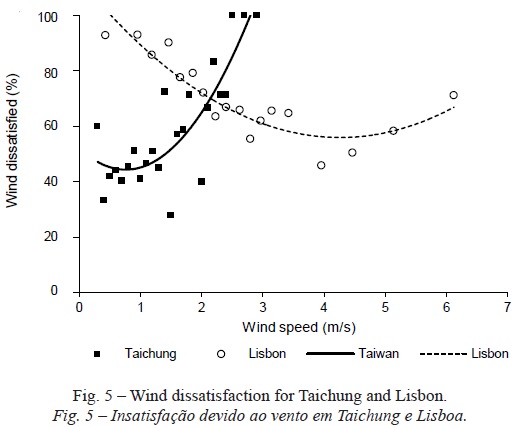
Furthermore, at the low wind speed of 1 m/s, the majority of people in Lisbon are dissatisfied, whereas most people in Taichung are satisfied. Compared to people in Taichung, the result indicates that people in Lisbon prefer to have some wind than no wind at all in summer.
IV. CONCLUSION
The results of the analysis of the overall thermal comfort dissatisfaction indicate that people in Taichung have higher tolerance to thermal comfort conditions (e.g. PET) when compared to people in Lisbon. However, people in Lisbon have higher tolerance to wind speed than those in Taichung. These results can be explained by the long-term climatic conditions; Taichung has higher air temperature, humidity and global radiation, while Lisbon has higher wind speeds.
The results display the thermal adaptation in different areas and reveal that local climate assessment must be considered when dealing with this issue. While discussing the thermal environment in urban areas, it is important to offer the information of the ‘users’ thermal comfort range to understand their sensation and preferences regarding different thermal conditions. For regions with dissimilar types of climate, different criteria for outdoor spaces should be applied, adjusted to the preferences of the local people and the long-term climatic conditions. This study also demonstrates the importance of outdoor field survey data of the local people, to contribute for the design of more comfortable outdoor spaces in urban areas. These issues are not only significant for general conditions, but are also relevant for facing climate change and apply suitable adaptation strategies for humans, particularly in urban areas.
BIBLIOGRAPHY
Andrade H, Alcoforado MJ, Oliveira s (2011) Perception of temperature and wind by users of public outdoor spaces: relationships with weather parameters and personal characteristics. International Journal of Biometeorology, 55(5): 665-680. [ Links ]
Ashrae (2010) Ashrae standard 55-2010. Thermal environmental conditions for human occupancy. American society of Heating, refrigerating and air-conditioning engineers, inc.: atlanta.
CEN STANDARD EN15251 (2007) Indoor environmental input parameters for design and assessment of energy performance of buildings addressing indoor air quality, thermal environment, lighting and acoustics. Brussels. [ Links ]
de Dear rJ, fountain Me (1994) field experiments on occupant comfort and office thermal environments in a hot-humid climate. ASHRAE Transactions, 100(2): 457-474. [ Links ]
Eliasson I, Knez I, Westerberg U, Thorsson S, Lindberg F (2007) Climate and behaviour in a nordic city. Landscape and Urban Planning, 82(1-2): 72-84. [ Links ]
Höppe P (1999) The physiological equivalent temperature - a universal index for the biometeorological assessment of the thermal environment. International Journal of Biometeorology, 43(2): 71-75. [ Links ]
Hwang RL, Lin TP (2007) Thermal comfort requirements for occupants of semi-outdoor and outdoor environments in hot-humid regions. Architectural Science Review, 50(4): 60-67. [ Links ]
Hwang RL, Lin TP, Kuo NJ (2006) field experiments on thermal comfort in campus classrooms in Taiwan. Energy and Buildings, 38(1): 53-62. [ Links ]
Kántor N, Egerhazi L, Unger J (2012a) subjective estimation of thermal environment in recreational urban spaces-Part 1: investigations in Szeged, Hungary. International Journal of Biometeorology , 56(6): 1075-1088. [ Links ]
Kántor N, Unger J, Gulyas A (2012b) subjective estimations of thermal environment in recreational urban spaces-Part 2: international comparison. International Journal of Biometeorology, 56(6): 1089-1101. [ Links ]
Kottek M, Grieser J, Beck C, Rudolf B, Rubel F (2006) World Map of the Köppen-Geiger cli-mate classification updated. Meteorologische Zeitschrift, 15(3): 259-263. [ Links ]
Lin Ch, Lin TP, Hwang RL (2013a) Thermal comfort for urban parks in subtropics: understanding visitor’s perceptions, behavior and attendance. Advances in Meteorology, 2013. DOi: 10.1155/2013/640473 [ Links ]
Lin TP (2009) Thermal perception, adaptation and attendance in a public square in hot and humid regions. Building and Environment, 44(10): 2017-2026. [ Links ]
Lin TP, De Dear R, Hwang RL (2011) Effect of thermal adaptation on seasonal outdoor thermal comfort. International Journal of Climatology, 31(2): 302-312. [ Links ]
Lin TP, Matzarakis A (2008) Tourism climate and thermal comfort in sun Moon Lake, Taiwan. International Journal of Biometeorology, 52(4): 281-290. [ Links ]
Lin TP, Tsai Kt, Liao CC, Huang YC (2013b) Effects of thermal comfort and adaptation on park attendance regarding different shading levels and activity types. Building and Environment, 59(1): 599-611. [ Links ]
Matzarakis A, Mayer H, Iziomon MG (1999) applications of a universal thermal index: physiological equivalent temperature. International Journal of Biometeorology, 43(2): 76-84. [ Links ]
Matzarakis A, Rutz F, Mayer H (2007) Modelling radiation fluxes in simple and complex environments -application of the rayMan model. International Journal of Biometeorology, 51: 323-334. [ Links ]
Matzarakis A, Rutz F, Mayer H (2010) Modelling radiation fluxes in simple and complex environments: basics of the rayMan model. International Journal of Biometeorology, 54(2): 131-139. [ Links ]
Mayer H, Höppe P (1987) Thermal comfort of man in different urban environments. Theoretical and Applied Climatology, 38: 43-49. [ Links ]
Nakano J, Tanabe S (2004) Thermal comfort and adaptation in semi-outdoor environments. ASHRAE Transactions, 110(2): 543-553. [ Links ]
Nikolopoulou M, Baker N, Steemers K (2001) Thermal comfort in outdoor urban spaces: understanding the human parameter. Solar Energy, 70(3): 227-235. [ Links ]
Oliveira S, Andrade H (2007) An initial assessment of the bioclimatic comfort in an outdoor public space in Lisbon. International Journal of Biometeorology, 52(1): 69-84. [ Links ]
Thorsson S, Honjo T, Lindberg F, Eliasson I, Lim EM (2007) thermal comfort and outdoor activity in Japanese urban public places. Environment and Behavior, 39(5): 660-684. [ Links ]
Thorsson S, Lindqvist M, Lindqvist S (2004) thermal bioclimatic conditions and patterns of behaviour in an urban park in Goteborg, Sweden. International Journal of Biometeorology , 48(3): 149-156. [ Links ]
Received: April 2014; Accepted: October 2014
ACKNOWLEDGEMENTS
the survey in Taiwan was conducted in the framework of the fiOt project (nsC-94-2211-e-150-001), whereas the thermal comfort data in Portugal was collected within the UrbKlim project (POCi/GeO/61148/2000). Part of this research was carried out together with the late Henrique Andrade (1960-2013). thanks are due to Paulo Can ário for organizing and sending most of Henrique’s files. We also thank the referees for their suggestions on the manuscript.














